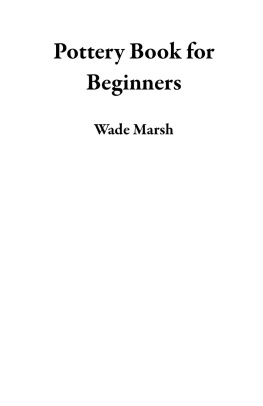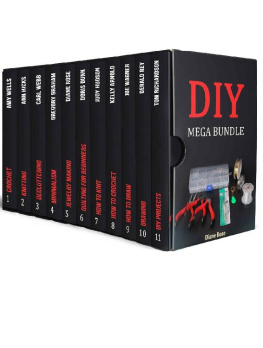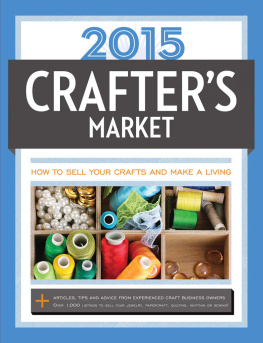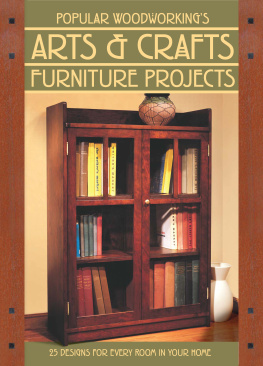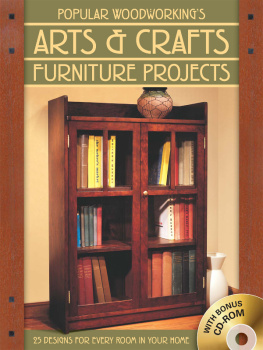CRAFT WISDOM & KNOW-HOW
Everything You Need to Know to Stitch, Sculpt, Bead and Build
From the Editors of Lark Crafts/Compiled by Amy Rost

Copyright 2011 Black Dog & Leventhal Publishers
All rights reserved. No part of this book, either text or illustration, may be used or reproduced in any form
without prior written permission from the publisher.
Published by
Black Dog & Leventhal Publishers, Inc.
151 West 19th Street
New York, NY 10011
Distributed by
Workman Publishing Company
225 Varick Street
New York, NY 10014
Cover design by Ohioboy Design
Cover illustration Elara Tanguy
The materials contained in this work are originally published and copyrighted
by Lark Books and used by permission of the publishers.
ISBN-13: 978-1-57912-863-0
eISBN: 978-1-60376-270-0
Library of Congress Cataloging-in-Publication Data available on file.
Beadwork
BEAD AND WIRE BASICS
Nathalie Mornu & Suzanne J. E. Tourtillot
For an artist, its no stretch to conceive of wire as a linear element, and beads as dots or points. The beauty of the projects in this book is that each transforms these simple building blocks into chic pieces to wear as ornament.
This chapter contains all the information you need to enter a world of creative expression making bead and wire jewelry.
Materials and Supplies
Shopping for the materials to create the projects in this book is a little like taking a trip around the globe: youll find African trade beads, lampworked glass crafted in India, cloisonn treasures made in China, shimmering Austrian crystal, and wire from, well, all over.
Beads
If youve never worked in this medium before, youre in for some pleasant hours of bead browsingthe hardest part is stopping! Youll find a fabulous range of beads in glass, semiprecious stone, ceramic, and polymer clay; you can buy lampworked one-of-a-kinds, silver- and rhinestone-studded spheres, and cloudy moonstone orbs. Sift through bins of carved wooden beads; pick up some bits of dichroic or tumbled glass. Build a collection and store it in stacks of beaders boxes with little compartments.
Most beads are organized in the stores by their material, shape, and diameter. (Tiny seed beads are sized using a special scale, in which the smallest ones have the highest numbers.) Be prepared to verify that your wire fits through your beads holes: some very large beads can have surprisingly small holes, and vice versa. Unfortunately, theres no standard relationship between the size of a beads hole and its diameter.
If you cant find beads to replicate the projects in this book, by all means purchase different styles; bear in mind that in doing so, you may achieve a completely different look, and youll need to make certain that your selections match the bead sizes specified in the instructions.

You can keep your beads organized by storing them in small boxes with clear lids.
Wire
Traditionally, wire made from sterling silver or gold has been a popular choice for bead and wire jewelry, but many other wire products may be used, too. Metal craft wire is now available in a wide variety of colors; relative newcomers include anodized and dyed metals such as aluminum, or niobium, which you can use alone or combined in the same piece of jewelry. Still other kinds of wire include brass, nickel, copper, and even platinum. Unlike these more malleable metals, super-springy memory wire, made from base metal or sometimes stainless steel, can be stretched and permanently bent, but it will always retain its initial coiled silhouette.
Whatever the metal, most wire comes in a large range of sizes and shapes, or profiles. Gauge is a scale of measurement that indicates a wires diameter: the higher the numeral, the finer the wire. (Memory wire is the exception; its sold in sizes to fit the neck, wrist, or finger.)
The projects in this book suggest that you use a specific size of wire, generally from 14 to 26 gauge. Using gauges other than those specified in the instructions is fine, but keep in mind that very thin wire, though easier to shape, isnt strong enough for a lot of heavy beads, and very thick wire isnt suitable for small-scale designsnot to mention the limitation of the size of a beads hole. Wires of the same gauge will all feel a bit different to manipulate, because some metals are softer than others. However, wire stiffens a bit as you work with it, adding more support to your work. This process is called work hardening; if wire gets handled too much, it becomes brittle and breaks.
Silver and gold wires are made and sold in different hardnesses: dead soft, soft, and halfhard. In most cases, our designers have recommended the appropriate silver or gold wire hardness for their projects; when in doubt, use half-hard wire. Avoid dead-soft wire; its difficult to work with and wont retain shaping or angles.
Many of the projects use sterling silver wire, but wire made from an alloy (a blend of less expensive metals) is an acceptable substitute, especially for jewelry for everyday wear or for working an unfamiliar design or technique. Its a great idea to use practice wire (of a similar gauge and hardness) if you plan to make a piece of jewelry from very expensive wire. Any inexpensive alloy wire will do.
Depending on the metal, wire is sold many different ways: on spools, in prepackaged coils, by weight, and by length. Look for various types in jewelry supply shops, craft retailers, and in certain areas of hardware stores (including the electrical supply and framing departments). The Internet is also a vast resource for wire of every kind.
In addition to the plain round variety, wire is made with different cross-section profiles, such as square, half round, and triangular. Some wire companies sell lengths of pretwisted single-strand wire, or you can make your own with the pin vise tool, as explained later on. Twisted wire is also created when two lengths of nonround wire are twisted together for a beaded or rippled effect Its possible to alternate links of round, flat, and twisted wire with stunning results.
Clasps, Pins, and Such
Findings are prefabricated, basic jewelry pieces; they are made from many of the same kinds of metals that are available in unformed wire, and there are popular silver and gold options, too. Necklaces may not need them, but bracelets almost always require clasps. To make an earring design wearable, use ear wires or posts; brooches sometimes need pin backings. Beads are often linked with head pins or eye pins. The head pin is simply a short, straight piece of wire with one flattened end to stop the bead, whereas an eye pin has an open loop at one end of the wire section. For either type, you form another loop at the other end after a bead has been strung onto it. Choose extra-long pins if you plan to add more than one bead.
Its easy to trim off excess wire, but theres nothing to be done when theres not enough. Just like wire, head pins and eye pins are available in different gauges. Be sure theyll fit through the beads holes.
You can use commercial clasps or closures on any of the projects in this book, but in some cases our designers give you instructions on how to fashion them yourself, such as in the Sassy Pin. Making your own closures gives a piece of jewelry a more integrated look. Findings often become important elements to the overall design, so youll want to take care that even purchased ones are made of materials of a quality and style that complement it.


